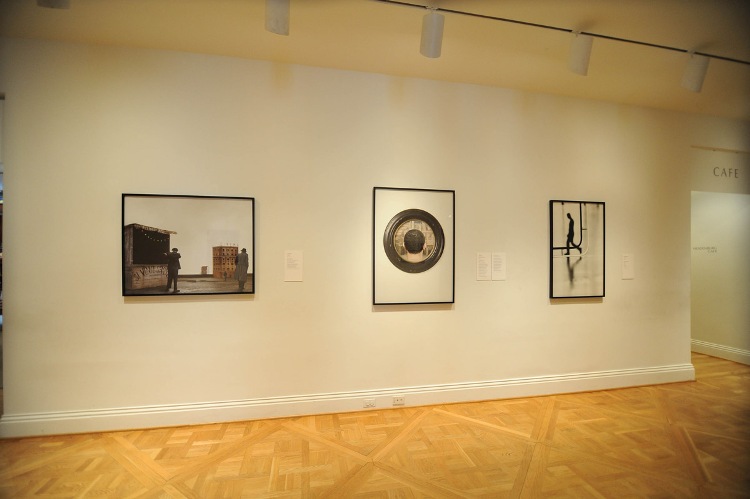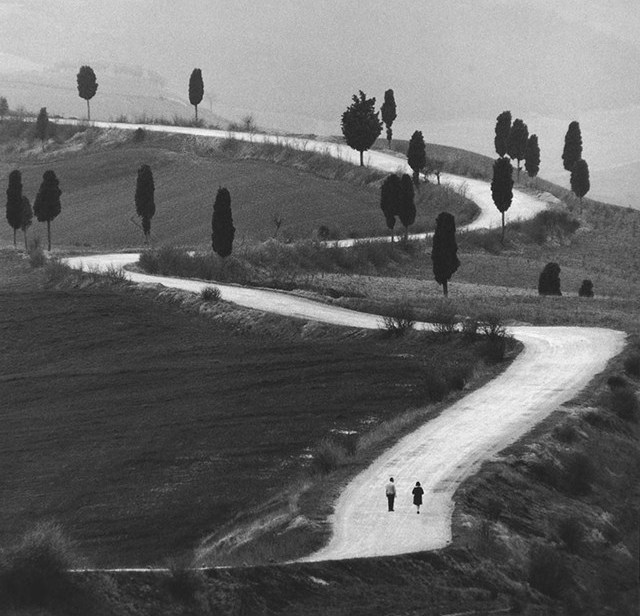As part of the 2013 Year of Italian Culture in the United States, the Phillips has partnered with the Embassy of Italy to present an exhibition that pairs contemporary Italian photographs with verses by celebrated Italian poets. On view at the Phillips through April 28, the show is complemented by posters featuring its photography/poem pairings on city buses. In honor of National Poetry Month, we bring you a selection from this series. Read Part I.

Next Stop Italy installation view by Joshua Navarro. Artworks left to right: Paolo Ventura’s “February 9” (2012), Mario Cresci’s “Pinacoteca Nazionale di Bologna (2010), and Renato D’Agostin’s “Paris” (2005).
Paolo Ventura (b. 1968, Milan), February 9, 2012
“Spesso il male di vivere ho incontrato” (1925)
Bene non seppi, fuori del prodigio
che schiude la divina Indifferenza:
era la statua nella sonnolenza
del meriggio, e la nuvola, e il falco alto levato.
“Again and again I have seen life’s evil” (1925)
I have known no good except the miracle
that reveals the divine Indifference:
it was the statue in the drowsy trance
of noon, and the cloud, the cruising falcon.
Eugenio Montale (translation by Jonathan Galassi, Charles Wright, and David Young)
Mario Cresci (b. 1942, Chiavari), Pinacoteca Nazionale di Bologna, 2010
“Supplica a mia madre” (1964)
È difficile dire con parole di figlio
ciò a cui nel cuore ben poco assomiglio.
Tu sei la sola al mondo che sa, del mio cuore,
ciò che è stato sempre, prima d’ogni altro amore.
Per questo devo dirti ciò ch’è orrendo conoscere:
è dentro la tua grazia che nasce la mia angoscia.
Sei insostituibile. Per questo è dannata
alla solitudine la vita che mi hai data.
E non voglio esser solo. Ho un’infinita fame
d’amore, dell’amore di corpi senza anima.
Perché l’anima è in te, sei tu, ma tu
sei mia madre e il tuo amore è la mia schiavitù:
ho passato l’infanzia schiavo di questo senso
alto, irrimediabile, di un impegno immenso.
Era l’unico modo per sentire la vita,
l’unica tinta, l’unica forma: ora è finita.
Sopravviviamo: ed è la confusione
di una vita rinata fuori dalla ragione.
Ti supplico, ah, ti supplico: non voler morire.
Sono qui, solo, con te, in un futuro aprile . . .
“Prayer to my mother” (1964)
It’s so hard to say in a son’s words
what I’m so little like in my heart.
Only you in all the world know what my
heart always held, before any other love.
So, I must tell you something terrible to know:
From within your kindness my anguish grew.
You’re irreplaceable. And because you are,
the life you gave me is condemned to loneliness.
And I don’t want to be alone. I have an infinite
hunger for love, love of bodies without souls.
For the soul is inside you, it is you, but
you’re my mother and your love’s my slavery:
My childhood I lived a slave to this lofty
incurable sense of an immense obligation.
It was the only way to feel life,
the unique form, sole color; now, it’s over.
We survive, in the confusion
of a life reborn outside reason.
I pray you, oh, I pray: Do not hope to die.
I’m here, alone, with you, in a future April . . .
Pier Paolo Pasolini (translation by Norman MacAfee with Luciano Martinengo)
Renato D’Agostin (b. 1983, Venice), Paris, 2005
“Mattina” (1917)
M’illumino
d’immenso
“Morning” (1917)
I flood myself with the light
of the immense
Giuseppe Ungaretti (translation by Andrew Frisardi)


